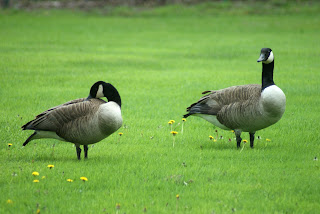Well, I've made it through my first week at the Albany Pine Bush!
Unfortunately it rained during almost our entire period of training. And since this is a field job, it meant a lot of time spent slogging through areas that looked like this:
But it's all good fun. So far, I think this is a really neat place. It's completely different from anything I've done before. I've always worked in places that were very remote, like on an island in Maine or in the middle of a Saskatchewan prairie. The Pine Bush, however, is an example of an urban ecosystem. Not originally, of course, but now the remainder of it is fragmented and interspersed with both housing and commercial developments. In other words, houses, businesses, and sometimes even malls can be seen from many of my study sites. It's unusual for me, but good, too. Not all habitats can be preserved in far-off places. Sometimes the most important are the ones right in people's backyards.
Most of the work I'll be doing this summer involves surveying for butterflies. Namely, the Karner blue butterfly, which is federally endangered, and the frosted elphin butterfly, which is threatened in New York State. The Karner blue, in particular, depends on lupine plants.

The Karners don't actually feed on these plants, but lay their eggs on them. No lupines = no Karners. Luckily, lupines are really beautiful, and I think most people wouldn't mind having them around.

The lupines have particular habitat requirements, needing sandy soil in which to grow. The Pine Bush is the perfect place, because it's made entirely from sand dunes! I just love these flowers. Occasionally, I'll come across a white one as well.

The Pine Bush is home to many threatened or rare species, which is what makes it so special and so important. This plant, called a birdfoot violet (for the shape of its leaves) is found nowhere else in New York State.

There are some really neat critters here, too. Yesterday, on my first day out by myself, I found this awesome little guy:

It's an eastern hognose snake, which is threatened in New York State. I've actually only seen its cousin, the western hognose, so I was really excited to find it. They're probably my favorite snakes. When they get scared, they puff up and hiss, which is what this one did when I picked it up. They've also been known to roll right onto their backs and play dead.
And that wasn't my only cool find of the day:

I stumbled right on a Song Sparrow nest! A couple years ago, I never would have found this nest. But my graduate work on prairie songbirds in Saskatchewan was entirely based on my ability to find nests on the ground. A lot of that ability comes from recognizing when a bird is flushing from a nest by observing its behavior. When I was walking along yesterday and saw a Song Sparrow fly very suddenly from close by on the ground, I knew there had to be a nest, and within a few seconds I found it!
What I found especially interesting is that these eggs look exactly like the eggs of both Savannah and Baird's sparrows, which I studied out west. I'm willing to bet these species are all closely related (clay-colored and Brewer's sparrows eggs, for example, are a solid robins-egg blue).
I might be doing some nest-searching for prairie warbler nests later in the summer. That will also be a bit different for me, because prairie warblers nest in shrubs that are off the ground, instead of right ON the ground.
 The "classic" Pine Bush is comprised of a mixure of pitch pine and scrub oak. It makes for a beautiful landscape, though the scrub oaks can be very difficult to move around in. The Pine Bush is a fire-dependent ecosystem, and if it isn't burned regularly, the scrub oak will take over entirely and almost nothing else can grow. Unfortunately, only about 25% of the preserve looks like this. The other 75% is deciduous forest. Which in some cases can be a good thing, but in this case it's not. Within five years, the preserve hopes to reverse those numbers. However, the variety of habitats means that many birds breed in the Pine Bush. This is a Field Sparrow nest with eight eggs, the most I've ever seen in a sparrow nest (look sideways).
The "classic" Pine Bush is comprised of a mixure of pitch pine and scrub oak. It makes for a beautiful landscape, though the scrub oaks can be very difficult to move around in. The Pine Bush is a fire-dependent ecosystem, and if it isn't burned regularly, the scrub oak will take over entirely and almost nothing else can grow. Unfortunately, only about 25% of the preserve looks like this. The other 75% is deciduous forest. Which in some cases can be a good thing, but in this case it's not. Within five years, the preserve hopes to reverse those numbers. However, the variety of habitats means that many birds breed in the Pine Bush. This is a Field Sparrow nest with eight eggs, the most I've ever seen in a sparrow nest (look sideways).
 Suddenly, a second later I emerged into a clearing that was completely Pine Bush, lupines and all. Most of these sites were woodland originally, but were restored to Pine Bush through clearcutting, mowing, and herbiciding the landscape, then replanting lupines and other native Pine Bush plant species.
Suddenly, a second later I emerged into a clearing that was completely Pine Bush, lupines and all. Most of these sites were woodland originally, but were restored to Pine Bush through clearcutting, mowing, and herbiciding the landscape, then replanting lupines and other native Pine Bush plant species.



















